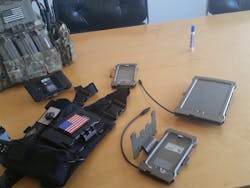Ariz. Firefighters Testing Military Communications System
They said they hope a new piece of communications technology, previously used by the military and adapted for wildfire fighters, will help.
Ralph Lucas, a battalion chief with the Prescott Fire Department, said he knew all 19 members of the Granite Mountain Hotshot crew. When federal officials approached him to test the communication and tracking system, he saw an opportunity to help protect other firefighters.
“One of the issues that occurred on the Yarnell Hill fire was resources not being able to locate one another,” Lucas said. “In the aftermath of the Yarnell Hill Fire, federal resources came to us and offered us some equipment that has been used in military applications, and they thought that we might be interested in trying to test some of this equipment.”
The Defense Advanced Research Project Agency, which creates and researches technology for the Defense Department, developed the system, the Fire Line Advanced Situational Awareness for Handhelds, or FLASH.
Special operations groups like the Navy SEALS and Army Green Berets used the system in combat. But after the Yarnell Hill Fire, the agency began looking at civilian applications for the system.
FLASH uses radios, handheld tablet computers and sensors to create an interactive “battlefield” for fighting fires. Firefighters on the ground can track fire locations, and command units can coordinate how best to fight the flames.
“It comes down to situational awareness,” said Chris Stalzer of Scottsdale-based Juggernaut Defense, a company that helped develop FLASH and its military counterpart. “The incident command will know where (firefighters) are, they’ll have good situational awareness because they can look to these maps for real-time data and then communicate to each other.”
Stalzer said situational awareness is key to firefighting, especially in diverse terrain.
In some areas, it can be nearly impossible to communicate because of a lack of relay antennas or geographic barriers, but FLASH can overcome these issues by creating a “mesh” network made from the radios and other technology that each individual or team carries.
The system weighs about 15 pounds and has a battery life of 12 to 15 hours with heavy use. It is designed to go into the most rugged areas and survive underwater or in heavy dust.
But the system isn’t ready for widespread use just yet.
“Another issue we have been talking about is the cost,” Lucas said. “These units with the harnesses cost $12,000 each as they sit right now. For agencies to be able to purchase something like that, it would be really expensive. But there are ways we can simplify the system, decrease its weight and bring it to a much more manageable cost.”
Lucas and Prescott Fire have been beta testing the FLASH system since summer 2014.
The battalion chief said he expects a lighter, more effective system will be available by the 2016 wildfire season.
Stalzer agreed. He said his company is reworking its designs to shed weight and make something more effective.
Technology can help, but it is only part of the firefighting equation, experts said.
“The biggest avenue to protect firefighter safety is training,” said Sean Newton, a director in emergency services training at Mesa Community College. “Firefighters rely heavily on quality simulated training, especially when they are talking about high-risk, low-frequency events. Those that don’t happen that often.”
“We have a phrase that we use,” Newton said. “ ‘Practice how you play.’ We try to make our practice scenarios as realistic as possible in order to prepare us for that incident and that’s how firefighters get better, through high-intensity training.”
––––
(Cronkite News reporters Julia Thatcher and Lauren Klenda contributed to this report.)
Distributed by Tribune Content Agency, LLC
